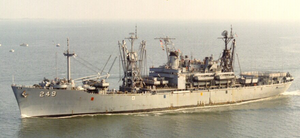
USS Essex (CV/CVA/CVS-9) was an aircraft carrier and the lead ship of the 24-ship Essex class built for the United States Navy during World War II. She was the fourth US Navy ship to bear the name. Commissioned in December 1942, Essex participated in several campaigns in the Pacific Theater of Operations, earning the Presidential Unit Citation and 13 battle stars. Decommissioned shortly after the end of the war, she was modernized and recommissioned in the early 1950s as an attack carrier (CVA), eventually becoming an antisubmarine aircraft carrier (CVS). In her second career, she served mainly in the Atlantic, playing a role in the Cuban Missile Crisis. She also participated in the Korean War, earning four battle stars and the Navy Unit Commendation. She was the primary recovery carrier for the Apollo 7 space mission.

USS Raleigh (LPD-1), the lead ship of her class of amphibious transport docks, was the fourth ship of the United States Navy named for the capital of North Carolina, which in turn honors the English explorer Sir Walter Raleigh, the first to attempt the establishment of an English settlement in the United States of America.

USS Shreveport (LPD-12) was an Austin-class amphibious transport dock. It was the second ship of the United States Navy to be named for the city in Louisiana. Her keel was laid down on 27 December 1965 by the Lockheed Shipbuilding and Construction Company of Seattle, Washington. She was launched on 22 October 1966 sponsored by Mrs. Andrew McBurney Jackson, Jr., and commissioned on 12 December 1970.

USS Paul Revere (APA/LPA-248) was the lead ship of the Paul Revere class of attack transport in the United States Navy. She was named for the early patriot and Founding Father, Paul Revere (1735–1818). She later served in the Spanish Navy as Castilla (L-21).

USS Fort McHenry (LSD-43) is a Whidbey Island-class dock landing ship of the United States Navy. She was named for Fort McHenry, in Baltimore, Maryland, the 1814 defense of which inspired "The Star-Spangled Banner".

USS Rockbridge (APA-228) was a Haskell-class attack transport in service with the United States Navy from 1944 to 1947 and from 1950 to 1968. She was scrapped in 1969.

USS Shadwell (LSD-15) was a Casa Grande-class dock landing ship in the United States Navy. She was named after Shadwell plantation, Albemarle County, Virginia, the birthplace and early home of Thomas Jefferson, author of the Declaration of Independence and third President of the United States.

USS Lenawee (APA-195) was a Haskell-class attack transport in service with the United States Navy from 1944 to 1946 and from 1950 to 1967. She was scrapped in 1975.
USS Terrebonne Parish (LST-1156), originally USS LST-1156, affectionately nicknamed the "T-Bone" by her early crew, was a Terrebonne Parish-class tank landing ship built for the United States Navy in 1952. The lead ship in her class, she was named for Terrebonne Parish, Louisiana, the only U.S. Navy vessel to bear the name. The ship was later transferred to Spain and renamed Velasco (L-11), and was scrapped in 1994.
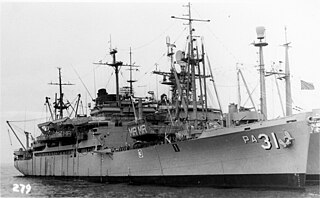
USS Monrovia (APA-31) was a Crescent City class attack transport of the United States Navy, built from a C-3 Delta commercial freighter design, and was named for the Birthplace of President James Monroe, located in Westmoreland County, Virginia.

USS Olmsted (APA-188) was a Haskell-class attack transport that saw service with the US Navy for the task of transporting troops to and from combat areas. She was of the VC2-S-AP5 Victory ship design type. Olmsted was named for Olmsted County, Minnesota.
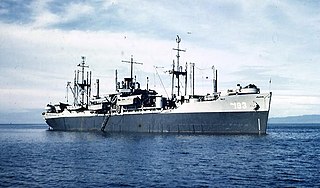
USS Sanborn (APA-193) was a Haskell-class attack transport acquired by the U.S. Navy during World War II for the task of transporting troops to and from combat areas.

USS Sandoval (APA-194/LPA-194) was a Haskell-class attack transport in service with the United States Navy from 1944 to 1946, from 1951 to 1955 and from 1961 to 1970. She was scrapped in 1983.
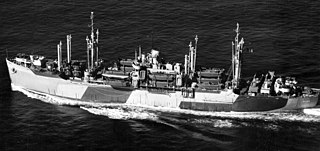
USS Magoffin (APA/LPA-199) was a Haskell-class attack transport in service with the United States Navy from 1944 to 1946 and from 1950 to 1968. She was scrapped in 1980.

USS Telfair (APA/LPA-210) was a Haskell-class attack transport that saw service with the US Navy in World War II and the Korean War. She remained in service through most of the 1950s and 1960s, where she participated in various peacetime operations. Telfair was named for Telfair County, Georgia, which was itself named after Edward Telfair, the second Governor of the state, a member of the Continental Congress, and a signer of the Articles of Confederation.

USS Mountrail (APA/LPA-213) was a Haskell-class attack transport of the US Navy in World War II, the Korean War and Vietnam War era. She was of the VC2-S-AP5 Victory ship design type. Mountrail was named for Mountrail County, North Dakota.

USS Noble (APA-218) was a Haskell-class attack transport which saw service with the US Navy in World War II, the Korean War, and the Vietnam War. She was transferred to the Spanish Navy in 1964 under a mutual assistance agreement. Noble was named after Noble County, Indiana, Noble County, Ohio, and Noble County, Oklahoma.
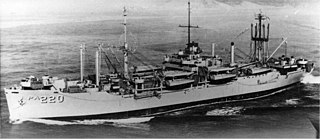
USS Okanogan (APA/LPA-220) was a Haskell-class attack transport that saw service with the US Navy in World War II, the Korean War and the Vietnam War. She was of the VC2-S-AP5 Victory ship design type and named after Okanogan County, Washington.

USS Ruchamkin (APD-89), ex-DE-228, later LPR-89, was a United States Navy high-speed transport in commission from 1945 to 1946, from 1951 to 1957, and from 1961 to 1969. She subsequently served as ARC Córdoba in the Colombian Navy, until 1980; although scrapped, her hull and superstructure were re-erected in a leisure park near Bogotá.

USS Kirwin (APD-90), ex-DE-229, later LPR-90, was a United States Navy high-speed transport in commission from 1945 to 1946 and from 1965 to 1969.
